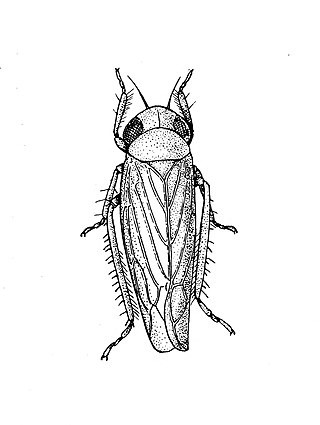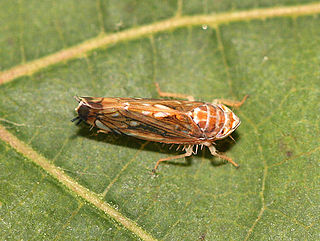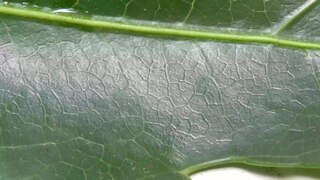
The glassy-winged sharpshooter is a large leafhopper, similar to other species of sharpshooter.

Leafhopper is the common name for any species from the family Cicadellidae. These minute insects, colloquially known as hoppers, are plant feeders that suck plant sap from grass, shrubs, or trees. Their hind legs are modified for jumping, and are covered with hairs that facilitate the spreading of a secretion over their bodies that acts as a water repellent and carrier of pheromones. They undergo a partial metamorphosis, and have various host associations, varying from very generalized to very specific. Some species have a cosmopolitan distribution, or occur throughout the temperate and tropical regions. Some are pests or vectors of plant viruses and phytoplasmas. The family is distributed all over the world, and constitutes the second-largest hemipteran family, with at least 20,000 described species.

The Auchenorrhyncha suborder of the Hemiptera contains most of the familiar members of what was called the "Homoptera" – groups such as cicadas, leafhoppers, treehoppers, planthoppers, and spittlebugs. The aphids and scale insects are the other well-known "Homoptera", and they are in the suborder Sternorrhyncha.

Curly top is a viral disease that affects many crops. This disease causes plants to become smaller in size, have shriveled petals and leaves, and are twisted and pulled out of shape. They are often caused by curtoviruses, members of the virus family Geminiviridae. This disease is important in western United States, such as California, Utah, Washington, and Idaho.

The beet leafhopper, also sometimes known as Neoaliturus tenellus, is a species of leafhopper which belongs to the family Cicadellidae in the order Hemiptera.

Elm yellows is a plant disease of elm trees that is spread by leafhoppers or by root grafts. Elm yellows, also known as elm phloem necrosis, is very aggressive, with no known cure. Elm yellows occurs in the eastern United States, and southern Ontario in Canada. It is caused by phytoplasmas which infect the phloem of the tree. Similar phytoplasmas, also known confusingly as 'Elm yellows', also occur in Europe. Infection and death of the phloem effectively girdles the tree and stops the flow of water and nutrients. The disease affects both wild-growing and cultivated trees.

Flavescence dorée is one of the most important and damaging phytoplasma diseases of the vine with the potential to threaten vineyards. The bacterial agent has recently been named Candidatus Phytoplasma vitis, and its vector is the leafhopper, Scaphoideus titanus. Infection may kill young vines and greatly reduce the productivity of old vines. It is classified as a phytoplasma disease belonging to the group generically termed grapevine yellows. Occurrences are in sporadic epidemics, and varieties vary in their sensitivity to it.

Graphocephala coccinea is a meadow and woodland-dwelling species of brightly colored leafhopper native to North and Central America, from Canada south to Panama. Common names include candy-striped leafhopper, red-banded leafhopper, scarlet-and-green leafhopper and red-and-blue leafhopper.

The common brown leafhopper is one of the most common species of Australian leafhoppers with a very wide host range. It is an important vector of several viruses and phytoplasmas worldwide. In Australia, phytoplasmas vectored by O. orientalis cause a range of economically important diseases including legume little leaf, tomato big bud, lucerne witches broom, potato purple top wilt, Australian lucerne and the insect is a possible vector of Australian grapevine yellows. O. orientalis also transmits Tobacco yellow dwarf virus to beans, causing bean summer death disease and to tobacco, causing tobacco yellow dwarf disease.

Scaphoideus titanus, the American grapevine leafhopper, is an insect of the leafhopper family (Cicadellidae) which feeds on various plants of the family Vitaceae. Native to North America, it was introduced by accident to Europe where it has become a pest by acting as a vector of the grapevine phytoplasma disease flavescence dorée. Mating requires species-specific vibrational patterns that males emit to the females, which are often victim to reproductive interference, including vibrational mating disruption caused by humans for pest control purposes. Nymphs do not engage in vibrational communication.
Deltocephalus is a leafhopper genus in the subfamily Deltocephalinae.
Cicadulina mbila, the maize leafhopper, is a leafhopper species in the genus Cicadulina.

Japananus hyalinus, the Japanese maple leafhopper, is a species of leafhopper of the subfamily Deltocephalinae and tribe Opsiini. Believed to be native to eastern Asia, it has been carried with the trade in cultivated maples and is now widely found in Europe, North America and Australia.
Curtovirus is a genus of ssDNA viruses, in the family Geminiviridae. Dicotyledonous plants serve as natural hosts. Curtoviruses are transmitted by leafhoppers. There are three species in this genus. Diseases associated with this genus include: Curly top disease.

Scaphoideus atlantus is a species of leafhopper in the family Cicadellidae.

Scaphoideus intricatus is a species of leafhopper in the family Cicadellidae.

Scaphoideus pullus is a species of leafhopper in the family Cicadellidae.

Scaphoideus festivus is a species of leafhopper in the family Cicadellidae.

Nephotettix is a genus of leafhoppers in the subfamily Deltocephalinae and tribe Chiasmini. Species are mostly found in Asia, although two are from Africa.

Jikradia olitoria is a species of leafhopper found mainly in eastern North America. The insect acts as a vector for the North American grapevine yellows.


















